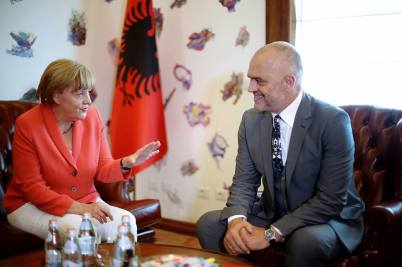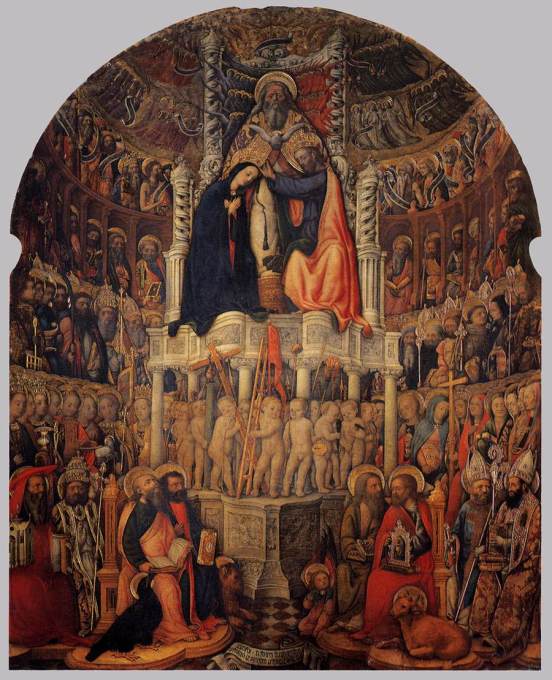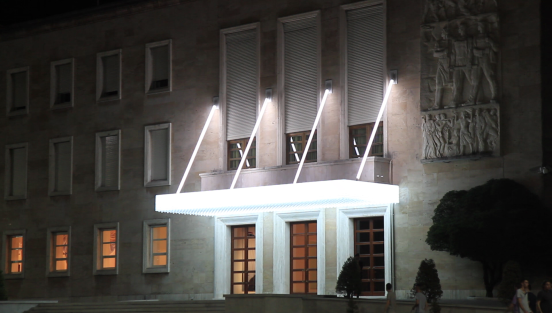See the original in DeMaterializacija Umetnosti: http://dematerijalizacijaumetnosti.com/od-pecina-laskoa-do-centra-za-otvorenost-i-dijalog-otkrivanje-i-raspecinjivanje-edija-rame-ii-deo/
Erasing and reproducing / Divide et Impera – Tirana in Edi Rama’s era, beyond the painted facades and erasure of terrible illegal buildings in the main streets of the city, experienced a sort of architectural bulimia. The cleaned and colorful main streets’ buildings masked the illegal buildings that occupied the public space within the quarters, beyond the facades. Tirana during 11 years with Edi Rama as Mayor, although the 123.000 tons of concrete “cleaned” by the Municipality, augmented at least 50% in terms of building densification, as if the Municipal authority did not existed. The green space arrived around 0,8m2/person, the lowest in Europe. Tirana’s inhabitants in Rama’s era have seen sacrificed their public space for the facades. But, as Edi Rama says, “we take care about the front, you [as citizen] take care about your back”[1], as if the “back” were a sort of Far West to colonize by bandits and oligarchs, as already happened in Tirana during these years.
Various times Edi Rama was accused for corruption (for the legalization, according the voices from the opposition, about 20% of the price of each building were paid to corrupt the Municipal administration), but no court decision has arrived in a definitive conclusion. However, beyond the expectations in Albanian judicial system, the most important thing to notice in this action, is that – as Edi Rama says – “it was a political action with colors”. And he always connects this action with the financial profits of the commercial activities situated in those buildings and the consecutive payment of the taxes to the Municipality. So, without speculating on Rama’s true or false corruption, it could be said for sure that Rama’s action is a classical action of cognitive capitalism.
The turn of the screw – Edi Rama is now, from 2013, Prime Minister of Albania. He actually controls all urban and architectonic projects of the country. For this reason from 2014 his executive chooses Atelier Albania, which is an entity, without a legal statute, inside the Ministry of Urban Development and Tourism, that controls all the urban and architectural projects (tenders, competitions, open calls, etc.) of the country, by deciding its formal administration, requirements, and all the members of the juries. In this case we are in front, not of some speculation, but of a sure institutionalization of the immediate control of the entire urban and architectural investments of the country.
 Atelier Albania is a creation of the Geroge Brugmans, the Dutch director of International Architecture Biennale of Rotterdam (IABR) and the Belgian architectural studio 51N4E (Edi Rama’s and Anri Sala’s personal friends that has projected TID tower in the city center and city’s central square).
Atelier Albania is a creation of the Geroge Brugmans, the Dutch director of International Architecture Biennale of Rotterdam (IABR) and the Belgian architectural studio 51N4E (Edi Rama’s and Anri Sala’s personal friends that has projected TID tower in the city center and city’s central square).
Maybe to the non Albanian readers could sound strange that a single man controls the urban and architectural projects of a country by choosing directly an foreign entity such as Atelier Albania. However it is possible, because I have personally confirmed it by myself writing an e mail in June 2016[2] to the director Brugmans, which admitted that:
Atelier Albania was an initiative of myself, and thus of IABR – a logical thing for me to do as we, at the time, were also running Ateliers in Istanbul, in São Paulo, and in The Netherlands. I thought the instrument of the Atelier would be very helpful in the Albanian situation given the need for deep reflection on new sustainable spatial development and planning policies. I brought 51N4E in and together we explained the concept to Edi Rama. This all happened at the Next Generation Albania meeting in Tirana, in August 2013, that is, before Edi Rama’s new government was officially installed. Subsequently, the concept was further discussed with Edi Rama, and with the Deputy Prime Minister, Niko Peleshi, and the Minister of Urban Development, Eglantina Gjermeni, after which the Atelier was installed in the first months of 2014.
The director of IABR was also so kind to send me the book Metabolism of Albania, published by the Atelier Albania. However when asked about the transparency[3], the contradictory and superficial concept[4], the conflict of interests[5], the lack of a competition for the position that Atelier Albania occupied within a national public institution, the absolute lack of public hearings before each project, and the risks of gentrification and/or colonization of a complex cultural territory such as Albania, the answer from IABR most representative figure, or better, his secretary, was:
Unfortunately Mr. George Brugmans doesn’t have the time at this moment to answer the question you have, he is very busy with the preparations for IABR 2018. Next to that, the IABR has withdrawn herself from Atelier Albania. The presentation at IABR 2016 was the last thing carried out for the Atelier by the IABR. Unfortunately we can’t help you any further[6].
Beyond the obvious suspects on corruption, in this case, it is important to notice the similarities of Atelier Albania with the fascist SVEA or the Institute of Constructions of the socialist period and, most important, the further development. The Atelier is in fact the synthesis of SVEA, in terms of foreigners’ undisputed expertise to influence the territorial control, and Institute of Constructions, in terms of territorial discipline, but also their perfect development in a perfect synthesis. So to say, Atelier Albania, which is created by two foreign institutions, uses as usual the foreign undisputed “art” par excellence as the fascist SVEA potentiating further the discipline of socialist realism (that in architecture for the abovementioned reasons in socialist totalitarian period was not yet so categorical), not to discipline (like the socialist regime), nor to influence (like SVEA), but to control immanently the territory. So, every project that comes out from the Atelier is artistically and politically functional for the territory that would only benefit from them.
Discaverning Edi Rama – As noticed we are talking about the infrastructure of a political and artistic system which is grown up in parallel with Edi Rama’s personal artistic and political carrier. Very few critics sees Edi Rama in the laboratorial perspective of cognitive capitalism, that in Albania, with Edi Rama, has reached a further and unique step in terms of society’s control[7], that in arts fields, the field of resistance par excellence as conceived by Deleuze[8], has its last griping territory.
Edi Rama is not like Mussolini influencing the Italian Rationalist architects, or Hitler influencing Albert Speer or Leni Riefenstahl; neither Georges Pompidou that opens the doors to the contemporary arts; nor Enver Hoxha that dictates and disciplines the society through the socialist realism, as the only “good art” for the socialist society; he is a new figure representing the capitalistic cognitive control that makes in each of his actions art and politics in the same time, immediately, immanently.
Of course are well-known his doodles, art and political executive deliberations or resolutions in the same time, and for this reason proclaimed as the “embodiment of present-mindedness”[9].
And the cognitive capitalistic machine that stands behind Edi Rama, which informs, conforms and deforms us for his worldwide confirmation – without explaining entirely Rama’s laboratorial aspects – is called sometimes Anri Sala (worldwide famous contemporary artist), Hans Ulrich Obrist (worldwide famous art curator), Marian Goodman Gallery[10], Galerie Michael Schultz[11], Tate Modern[12], etc.; in other words the machine is almost the maximal expression of worlds’ arts system.
This machine is promoting Edi Rama artistically and politically (img. 14). The system continues to promote ones more a contemporary mysterious art within a cave, which in is represented by Edi Rama’s personal office in the Prime Minister building and the newly opened Center for Openness and Dialogue[13] (COD, an exhibition space opened in 2015, situated in the first floor of the building).
 A closer look of Edi Rama’s office in the Prime Minister’s building (see the walls in img. 14) demonstrates the frenzy to fulfill with his own art a representative space for politics and arts, marked firstly by the Italian fascist architect Gherardo Bosio, that fulfilled the Mussolinan colonialist and imperialistic politics in the ’40; and secondly by Enver Hoxha, through Edi Rama’s father and other Albanian sculptors (see bas-relief in img. 1), that fulfilled the wish for the socialist demarcation of the building in the ’70. The building and the office itself is a sort of psychotic space that shows exactly the contrary of what it tries to show: a lack, a void, an absence of arts and/or politics. In the history of arts, for example, this phenomena is known from the venetian paintings of the 15th century (img. 15).
A closer look of Edi Rama’s office in the Prime Minister’s building (see the walls in img. 14) demonstrates the frenzy to fulfill with his own art a representative space for politics and arts, marked firstly by the Italian fascist architect Gherardo Bosio, that fulfilled the Mussolinan colonialist and imperialistic politics in the ’40; and secondly by Enver Hoxha, through Edi Rama’s father and other Albanian sculptors (see bas-relief in img. 1), that fulfilled the wish for the socialist demarcation of the building in the ’70. The building and the office itself is a sort of psychotic space that shows exactly the contrary of what it tries to show: a lack, a void, an absence of arts and/or politics. In the history of arts, for example, this phenomena is known from the venetian paintings of the 15th century (img. 15). In those paintings it is expressed the uncertainty of the Venetian Republic inhabitants’ towards the faith and on the Papal State as representative institution of God. The clerics used exactly to commission this kind of art works as they believed that through them could have demonstrate the “embodiment of the presence”[14], on which Venetians doubted.
In those paintings it is expressed the uncertainty of the Venetian Republic inhabitants’ towards the faith and on the Papal State as representative institution of God. The clerics used exactly to commission this kind of art works as they believed that through them could have demonstrate the “embodiment of the presence”[14], on which Venetians doubted.
Another closer look must be focused on Prime Minister’s COD, which could be considered a beautiful action to assure a new space for Albanian artists. But in the same year of COD’s opening Edi Rama’s government provided the National Gallery of Arts with 25.000$ per year, which is less than the cost of installation of Philippe Parreno’s art work Marquee, which shines in the entrance of Center for Openness and Dialogue (img. 16).  Of course the director of National Gallery of Arts, chosen and nominated, as mentioned, directly by Edi Rama, did not protests, although the only remained yearly event for contemporary arts, “Onufri”, programmed by the National Gallery of Art, was deleted (erased) for the first time in 20 years for the lack of finances, that generally consist in around 10.000$.
Of course the director of National Gallery of Arts, chosen and nominated, as mentioned, directly by Edi Rama, did not protests, although the only remained yearly event for contemporary arts, “Onufri”, programmed by the National Gallery of Art, was deleted (erased) for the first time in 20 years for the lack of finances, that generally consist in around 10.000$.
In this sense, seems like Albania is experiencing the post-Deleuzian vision:
[T]hese institutions are finished, whatever the length of their expiration periods. It’s only a matter of administering their last rites and of keeping people employed until the installation of the new forces knocking at the door. These are societies of control, which are in the process of replacing the disciplinary societies[15].
In this manner the machine of cognitive capitalism is showing once more its new/old face:
Faciality reigns materially over that whole constellation of signifiances and interpretations (psychologists have written extensively on the baby’s relations to the mother’s face, and sociologists on the role of the face in mass media and advertising). The despot-god has never hidden his face, far from it: he makes himself one, or even several. The mask does not hide the face, it is the face[16].
It is not so strange then to see Edi Rama act politically with the art on the facades, without hiding the face of the despot-god, because simply “it is the face”, the face of the abstract machine of the capital that controls by codifying (the acronym COD of Center for Openness and Dialogue maybe suggest exactly the codification) everything.
And Tirana’s new despot, as Kronos, fixed psychotically with the inscription of his “name in the history”[17] continues to erase, with his “brush’s bold strokes”[18], thousands of Romani people from their houses’[19], or “creating space there where appears to be none”[20] for the gentrification[21] and the profits of Tirana’s constructional oligarchs. The neoliberal Kronos of cognitive capitalism, that in Albania happens to be the Head of Socialist Party, continues to promote the terrible lack in Albania of the syndicates/unions of workers in front of Italian Industrialists’ Confederation, to attract them in his virgin paradise for easy profits[22], no matter that child or adult workers die[23], no matter that they die while[24] Edi Rama, the artist, is promoting itself throughout Big Apple.
As a conclusion, Gilles Deleuze can, still, illuminate:
In very general terms, we claim that there are two ways to appeal to ‘necessary destructions’: that of the poet, who speaks in the name of a creative power, capable of overturning all orders and representations in order to affirm Difference in the state of permanent revolution which characterizes eternal return; and that of the politician, who is above all concerned to deny that which ‘differs’, so as to conserve or prolong an established historical order, or to establish a historical order which already calls forth in the world the forms of its representation. The two may coincide in particularly agitated moments, but they are never the same.[25]
[1] See min. 1:12:00 http://www.tate.org.uk/context-comment/video/architectureart-crossover-and-collaboration-edi-rama-and-anri-sala
[2] It is important to know that this e mail was sent from my personal electronic address “@inha.fr” of L’Institut national d’histoire de l’art, when I was invited as a researcher. Previously I have sent several e mails to Atelier Albania, IABR and 51N4E, without any replay. I suspect that the previous e mails have had not very exiting domain such as the National Institute of History of Art in Paris.
[3] In Albania although exists the concept of public competitions, tenders, and call for proposals, to no one is allowed the access to see the documentation/proposals, because of the participants “copyright”. At least this is the justification of the administration that has never opened a single document of this public tenders.
[4] The fundamental concept of Atelier Albania is “research by design”, a clear colonialist concept, as the research comes after the design, after imposing a pre-fabricated design on the territory, without cultivating a specific laboratory for the interaction with the context.
[5] Edi Rama’s daughter in law was part of 51N4E. Also a scandal regarding Peter Swinen, partner of 51N4E and official architect of the Flemish government, happened in Belgium, because of the “conflict of interests” and “strong ties to the Albanian government” which causes his immediate dismissing. http://www.flanderstoday.eu/current-affairs/official-architect-peter-swinnen-dismissed-immediate-effect
[6] I have written in my personal blog on these issues, but no Albanian media seem to be interested.
Atelier Albania braktiset nga IABR. George Brugmans na la kopilin në derë. (Romeo Kodra)
[7] See and confront with the “Postscript on the Societies of Control”, by Gilles Deleuze.
[8] See the link in note 2.
[9] “What do we see when we are put in Rama’s seat of automatic creation? That in fact his drawing is the opposite of absentmindedness – it is the embodiment of present-mindedness.” – Anri Sala.
http://www.mariangoodman.com/exhibition/3840/press-release
[10] http://www.mariangoodman.com/exhibition/3840/installation-views
[11] http://www.schultzberlin.com/en/edi-rama
[12] See the link in footnote 21, min. 1:26:50.
[13] One of the members of COD’s board (http://cod.al/?page_id=21) is the curator of Centre Pompidou Christine Macel, the Venice Biennale curator for 2017.
[14] See footnote 30.
[15] Deleuze, Gilles Postscript on the Societies of Control.
[16] Deleuze, Gilles, Guattari, Felix, A Thousand Plateaus, University of Minnesota Press, Minneapolis, USA, pg. 115.
[17] “[I] didn’t become Edi Rama because of the politics. I was Edi Rama before. If I stay [in politics], is for doing something. I have a problem with death. It comes from the fact that I am an artist. I have a problem with death and history. I want to leave a name. I am not interested for anything else. I do politics to fight the idea of death.” https://www.courrierdesbalkans.fr/articles/albanie-edi-rama-le-premier-ministre-et-la-mort.html
[18] See min. 10.00 and min. 12.20 in https://www.youtube.com/watch?v=2sbs0pf0OXs
[19] https://www.youtube.com/watch?v=5d9GPIZj4_8
[20] This is part of an illogic title, Inversion – Creating Space Where There Appears To Be None (2010), for an illogical text edited by Anri Sala with promotional interviews of Edi Rama’s works.
[21] For the continuation of Tirana’s Boulevard projected when Edi Rama was Mayor of Tirana, in collaboration with the former right wing government of Sali Berisha, in 2015 Rama’s government decided to erase the houses giving to the owner the possibility to choose between a “2 years rent of an apartment” or a ridiculous reimbursement of price which is around 30% of the real estate price.
[22] https://www.youtube.com/watch?v=CTQHSDmKOdI
[23] http://www.exit.al/en/2016/11/02/ardit-gjoklajs-death-continues-to-haunt-veliaj/
[24] In the same day of the death of a worker in an oil refinery, because of the lack of any security conditions, the Albanian Prime Minister found the time to visit New York for his exhibition in Marian Goodman Gallery. https://www.youtube.com/watch?v=RQjEsirjvZg
[25] Deleuze, Gilles Difference and Repetition, The Cromwell Press, Trowbridge, Wilts, Great Britain, pg. 53.
